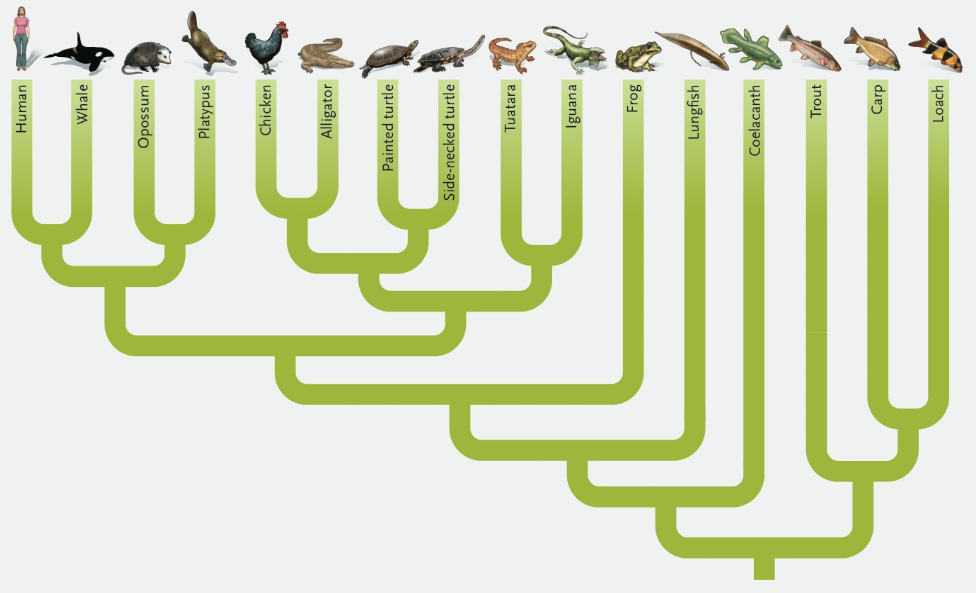
Biology: The Dynamic Science (MindTap Course List)
4th Edition
ISBN: 9781305389892
Author: Peter J. Russell, Paul E. Hertz, Beverly McMillan
Publisher: Cengage Learning
expand_more
expand_more
format_list_bulleted
Concept explainers
Textbook Question
Chapter 32, Problem 1ITD
The phylogenetic tree for vertebrates depicted below was constructed from sequence data for two rRNA mitochondrial genes (12S and 16S). How do the results of this analysis compare with the phylogenetic trees in Figures 32.10 and 32.24? Identify the major clades of vertebrates on the tree depicted below.

Source: R. Zardoya and A. Meyer. 1998. Complete mitochondrial genome suggests diapsid affinities of turtles. Proceedings of the National Academy of Sciences, USA 95:14226–14231. Copyright 1998 National Academy of Sciences, U.S.A.
Expert Solution & Answer
Trending nowThis is a popular solution!

Students have asked these similar questions
Other than oil and alcohol, are there other liquids you could compare to water (that are liquid at room temperature)?
How is water unique compared to these other liquids?
What follow-up experiment would you like to do, and how would you relate it to your life?
Selection of Traits
What adaptations do scavengers have for locating and feeding on prey?
What adaptations do predators have for capturing and consuming prey?
Competition Between Species
What natural processes limit populations from growing too large?
What are some resources organisms can compete over in their natural habitat?
Chapter 32 Solutions
Biology: The Dynamic Science (MindTap Course List)
Ch. 32.1 - What organ system is unique to echinoderms, and...Ch. 32.1 - How does a perforated pharynx enable hemichordates...Ch. 32.2 - On a field trip to a lake, a college student...Ch. 32.2 - Prob. 2SBCh. 32.3 - How do the Hox genes of vertebrates differ from...Ch. 32.3 - Prob. 2SBCh. 32.4 - Prob. 1SBCh. 32.4 - What traits in conodonts and ostracoderms are...Ch. 32.5 - Prob. 1SBCh. 32.5 - Prob. 2SB
Ch. 32.5 - Prob. 3SBCh. 32.6 - Prob. 1SBCh. 32.6 - What parts of the life cycle in most modern...Ch. 32.7 - How did the evolution of the amniote egg free...Ch. 32.7 - Prob. 2SBCh. 32.7 - Based on the evolutionary history of the amniotes,...Ch. 32.8 - Prob. 1SBCh. 32.8 - Prob. 2SBCh. 32.9 - Prob. 1SBCh. 32.9 - What anatomical and behavioral characteristics of...Ch. 32.9 - Prob. 3SBCh. 32.9 - How do the structures of a birds bill, wings, and...Ch. 32.10 - Prob. 1SBCh. 32.10 - Prob. 2SBCh. 32.10 - On what basis are the three major groups of living...Ch. 32.11 - Prob. 1SBCh. 32.11 - What is the lowest taxonomic group that includes...Ch. 32.11 - Prob. 3SBCh. 32.12 - Prob. 1SBCh. 32.12 - Prob. 2SBCh. 32.12 - Prob. 3SBCh. 32 - Which phylum includes animals that have a water...Ch. 32 - Which of the following is not a characteristic of...Ch. 32 - Prob. 3TYKCh. 32 - Prob. 4TYKCh. 32 - Prob. 5TYKCh. 32 - The Hominoidea is a monophyletic group that...Ch. 32 - Which of the following hominin species was the...Ch. 32 - Prob. 8TYKCh. 32 - Which of the following characteristics does not...Ch. 32 - Prob. 10TYKCh. 32 - Discuss Concepts Whentetrapods first ventured onto...Ch. 32 - Prob. 12TYKCh. 32 - Prob. 13TYKCh. 32 - Prob. 14TYKCh. 32 - Prob. 15TYKCh. 32 - Prob. 16TYKCh. 32 - Walking along a rocky coast one day, you discover...Ch. 32 - The phylogenetic tree for vertebrates depicted...
Knowledge Booster
Learn more about
Need a deep-dive on the concept behind this application? Look no further. Learn more about this topic, biology and related others by exploring similar questions and additional content below.Similar questions
- Species Interactions Explain how predators, prey and scavengers interact. Explain whether predators and scavengers are necessary or beneficial for an ecosystem.arrow_forwardmagine that you are conducting research on fruit type and seed dispersal. You submitted a paper to a peer-reviewed journal that addresses the factors that impact fruit type and seed dispersal mechanisms in plants of Central America. The editor of the journal communicates that your paper may be published if you make ‘minor revisions’ to the document. Describe two characteristics that you would expect in seeds that are dispersed by the wind. Contrast this with what you would expect for seeds that are gathered, buried or eaten by animals, and explain why they are different. (Editor’s note: Providing this information in your discussion will help readers to consider the significance of the research).arrow_forwardWhat is the difference between Uniporters, Symporters and Antiporters? Which of these are examples of active transport?arrow_forward
- What are Amyloid Fibrils? What biological functions are these known to perform?arrow_forwardHow do histamine and prostaglandins help in the mobilization of leukocytes to an injury site? What are chemotactic factors? How do they affect inflammation process?arrow_forwardCompare and contrast neutrophils and macrophages. Describe two ways they are different and two ways they are similar.arrow_forward
- Describe the effects of three cytokines (not involved in the initial inflammation response). What cells release them?arrow_forwardDescribe activation of helper T cells or cytotoxic T cellsarrow_forwardCompare and contrast MHC 1 and MHC 2. Describe two way they are different and two ways they similar including how they are used in antigen presentation.arrow_forward
arrow_back_ios
SEE MORE QUESTIONS
arrow_forward_ios
Recommended textbooks for you
 Biology: The Dynamic Science (MindTap Course List)BiologyISBN:9781305389892Author:Peter J. Russell, Paul E. Hertz, Beverly McMillanPublisher:Cengage Learning
Biology: The Dynamic Science (MindTap Course List)BiologyISBN:9781305389892Author:Peter J. Russell, Paul E. Hertz, Beverly McMillanPublisher:Cengage Learning

Biology: The Dynamic Science (MindTap Course List)
Biology
ISBN:9781305389892
Author:Peter J. Russell, Paul E. Hertz, Beverly McMillan
Publisher:Cengage Learning
Mitochondrial mutations; Author: Useful Genetics;https://www.youtube.com/watch?v=GvgXe-3RJeU;License: CC-BY